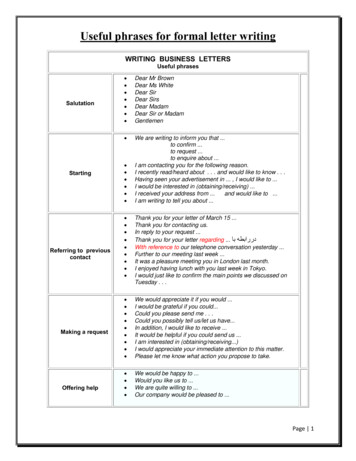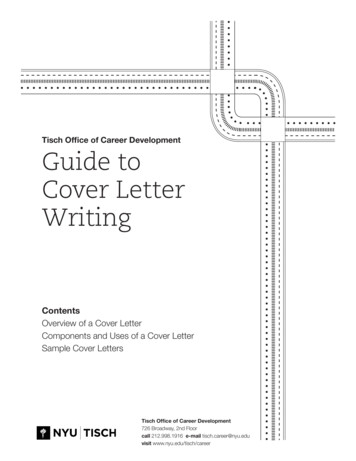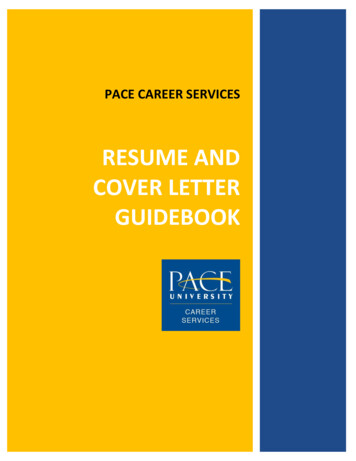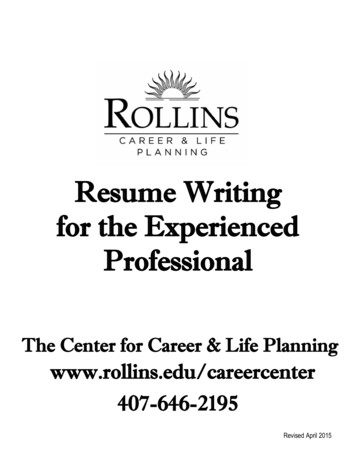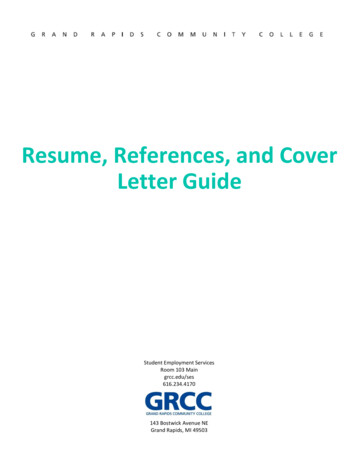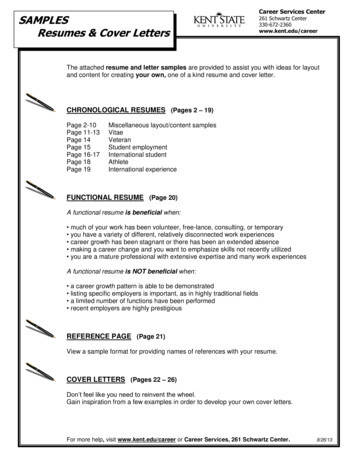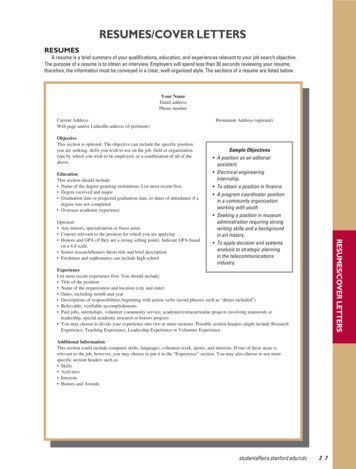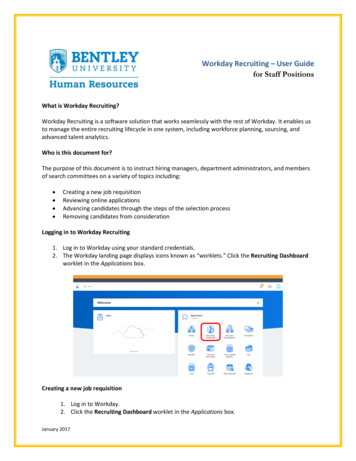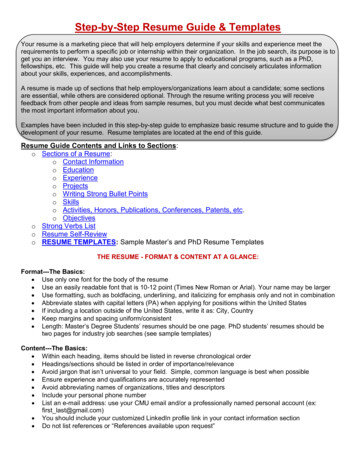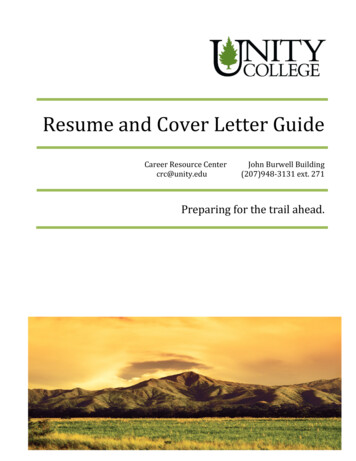
Transcription
Resume and Cover Letter GuideCareer Resource Centercrc@unity.eduJohn Burwell Building(207)948-3131 ext. 271Preparing for the trail ahead.
WHAT EMPLOYERS WANT TO KNOW ABOUT YOU?Skills & AbilitiesValues & InterestsWhat practical experience have you gained throughyour professional experience, volunteer experience oracademic projects? Are you a problem-solver? Whatare your transferable skills? Are you willing to learn?What is important to you? Do your personal intereststie into the mission of the company? What are youroutside interests? Are you a good fit? Will you be anethical employee? What motivates you?Academic PreparationProfessionalismDo you meet the minimum academic requirements?Do you have the necessary academic credentials? Doyou have a basic or advanced theoreticalunderstanding of the field? Do you have anintellectual curiosity? Do you have foundationalacademic background in your area along with abroader liberal arts background? Can you read, writeand communicate effectively? Can you applytheoretical knowledge to the real worldDo you have a strong work ethic? Can you makesound ethical decisions? Will you arrive to work ontime and demonstrate initiative? Will you work wellwith others, despite personality differences? Will youwork to support the mission of the organization? Howdo you conduct yourself outside of work-time? Willyou be a positive representative of the organization?Are you dedicated to growing personally andprofessionally? Are you affiliated with professionalorganizations and dedicated to keeping yourknowledge of the field/industry current?Your resume and cover letter are documents used to convey this information to potential employers. Resumestypically focus on your skills, abilities, education, and experience. Your cover letters typically address on yourvalues, interests, and professionalism.WHAT IS A RESUME?A resume is the most important document used in applying to professional positions, graduate school or forprofessional networking. A resume is a short synopsis of your credentials. Resumes are often the first contactyou will make with potential employers and should be tailored specifically to each position.Most employers spend less than 20 seconds reviewing your resume, for this reason it should be clear, conciseand focused while providing enough relevant information to capture their attention.WHAT TO INCLUDE?1. Full contact information: Name, complete address, email, phone number and LinkedIn profile link2. Objective statement, professional mission statement or a summary of qualifications section: This section should be tailored specifically to the position you are applying Include keywords (see below) and language similar to the company’s mission or valuesstatement. Keep it authentic and original but complementary.3. Education: Name of college(s), city & state of college, degree, major, GPA if 3.5 or better, year ofgraduation if recent (may be omitted if more than 10 years) May want to highlight scholarships, dean’s list or other academic honors Include study abroad or other accredited educational experiences in this section High school may be included, but not necessary4. Work and volunteer experience:Unity College Resume and Cover Letter Guide 2 P a g e
Job title, company, city & state of company, dates of employment Brief description of your duties or abilities focusing on transferable skills5. Certifications, licenses, skills and training: Include only current certifications along with certifying agencies and dates of expiration Include any relevant training or skill sets (ex. GIS, GPS, firearm safety, Leave No TraceTrainer, laboratory equipment knowledge, computer program experience6. Qualifications indicated on the job announcement: Ensure any required skills are explicitly indicated on your resume. Employers will notassume just because you are applying that you have the skills they need.7. List of References: If space allows include a list of at least three references. Be sure to include at least oneprofessional and academic reference. The third could be a second professional, academic orpersonal reference. Included complete contact information including: Full name, title, company, address,phone, and email Do not write references upon request. Make it easy for the employer. If space does not allow references on your resume. Include them anyway on a separatepaper with your same contact information header as your resume. (see personal brandingsection)FORMATS & STYLESUnless you are creating a resume for a federal government position, there is no universal resume format. Thereare only guidelines that you should follow. Content should be formatted and styled consistently throughoutyour resume. While there is some room for creativity, resumes should always be professional. Clip art and busyfonts should not be used on resumes; however a little color or clean lines may be used to focus attention orreflect a personal brand. Pictures should not be included unless it is required or relevant to your industry (i.e.modeling, acting, animal training presenter).TYPES OF RESUMESChronological: Focuses on individual jobs and transferable skills of each position, all positions listed in reversechronological order. This is the most common style for all job seekers and college students.Functional: This style focuses on the writer’s skills rather than past positions. Positions are listed but explainedin great detail. This style is used when a person has the same primary position at several companies or if thewriter is looking to change professional fields. Most employers typically do not favor this style, but for some it isan ideal way to organize information.Chronological/Functional Hybrid: A combination of chronological and functional resumes is used when thewriter has some relevant experience and some not. There is both a focus on skills and abilities as well as keyrelevant positions. Additional work history sections are used to list, but not emphasize irrelevant positions.Curriculum Vitae or CV: Curriculum Vitae translated to “life work”. Many people use CV interchangeably withresume. CV’s are generally used in the fields of research and higher education. It is also a term used commonlyin foreign countries in lieu of resume. The differentiating factor of a CV is the inclusion of publications andpresentations. CV’s are typically longer, sometimes much longer than a standard one or two page resume. Someacademia CV’s can be 30 pages. CV’s usually have “CV” or “Curriculum Vitae” written on the top of firstpage. It is usually placed directly above or below the contact information.PERSONAL BRANDINGPersonal Branding is very important for all application materials. A personal brand is what ties together all thematerials you are submitting as part of your application. The brand is accomplished by being consistent withabstract information like your values and interests, as well as consistency with concrete information like yourcontact information header. Be sure to use the same style and size fonts in all documents. Developing your ownunique and personalized header is a quick, easy and impressive way to develop your brand. It is used similar tostationary. A personal brand will send a collective and consistent message to the reader. The key to personalUnity College Resume and Cover Letter Guide 3 P a g e
branding is consistency and authenticity in representing your professional and personal values and physicallook of all application materials.KEYWORDSKeywords are commonly used words specific to certain industries. While most Unity College student resumeswill be read by an actual person, occasionally computers are used to screen qualified candidates. If this is thecase a resume that does not contain enough “keywords” may not make it into consideration regardless ofqualifications.To identify what keywords to include in your resume first look at the job announcement. Highlight the wordsthat seem to be the most significant and are listed as essential qualifications. Keywords can be skill specific suchas certain computer programs or can be characteristics such as team player. Another keyword resource is OnetOnline’s federal occupational database Insert website link. Simply enter the job title and use the occupationdescription to identify industry keywords. Lastly don’t overlook company websites and publications. Focus onareas such as mission statements, vision statements, or values to help you identify industry keywords. TheCareer Resource Center also has an extensive list of keywords for each major.TRANSFERABLE SKILLSTransferable skills are qualities and abilities that are useful regardless of the position held. They are not specificto one certain field. When describing a former position, it is best to focus on transferable skills rather than jobspecific skills, especially if you are looking to move in a new direction from former employment. For example ifyou worked at a fast food restaurant during high school, you would focus on skills such as: “ability to work in afast-paced, team environment while providing quality customer service”, rather than,” flipped burgers andoperated a cash register”.RESUME WRITING GUIDELINES1. Everything is listed in reverse chronological order2. Highlight your strengths and accomplishments3. Aim for two pages or less, unless creating a CV4. No more than two font styles or two font sizes, always format consistently5. No clip art, busy fonts or pictures6. Tailor each resume to the specific position, weighing requirements accordingly7. Always include keywords8. Ensure requirements of the position are listed in your resume9. Emphasize key strengths, never exaggerate or lie on your resume10. Match resume materials to other application documents such as cover letter or reference list tomaintain consistent personal brand11. Don’t overlook class projects, service projects or volunteer experience12. Focus on transferable skills, not job specific skills13. Use action words14. Make sure your verb tense is consistent. Present or past tense are acceptable.15. Focus on abilities rather than duties16. Always have at least two people look over your resume. Use the Career Resource Center professionalstaff they are specially trained in resume writing.SUBMITTING YOUR RESUMEHardcopiesHardcopy application materials should be printed on special resume linen bond paper using a high qualityprinter. The Career Resource Center has a full supply of resume paper for student use. Unless otherwisespecified, materials should be sent in a large letter size envelope. Address should be written neatly or printed onaddress labels (also available at the Career Resource Center). Be sure to sign your cover letter and submitcomplete application packages.Electronic submissionAlways follow the specific requests of employers. Some employers may request that all material be submitted inone document, separate documents, etc. If no specific guidelines are offered the default electronic submissionformat is as follows:Unity College Resume and Cover Letter Guide 4 P a g e
All items submitted together in one document Cover letter first, Resume, List of References, Application,then other required supporting documents.Be sure to use identifying information on the file names; ex. Chad.Westerhoff.Application.Materials.pdfYou may want to consider using an electronic signature on your cover letter. The Career ResourceCenter can help you create an electronic signature. (Please note there are some risks to sending yourpersonal signature electronically.)OTHER IMPORTANT APPLICATION DOCUMENTSTeaching portfoliosTranscripts (official and unofficial)Copies of certifications, licenses or other official documentsE- Portfolio websitesExperience logLetters of referenceList of referencesUnity College Resume and Cover Letter Guide 5 P a g e
C HE RYL BL OOMPO Box 6 Chatham, MA 01545 508.287.0626 CherylBloom@comcast.net Linked In ProfileCurriculum VitaeOBJECTIVEHighly motivated environmental professional with over 9 years of experience, seeking a challenging position inproject management with an environmentally sustainable organization or businessPROFESSIONAL SKILLS Experience drafting and submitting multi-volume environmental reports to federal regulatorsKnowledge of Massachusetts wetlands regulations with experience filing Notices of IntentWetland delineation field experienceEnvironmental inspection experienceKnowledge of erosion, sediment control, and stabilization techniquesAbility to multitask, prioritize, work independently and support organizational goalsExcellent management and organizational skillsEDUCATIONUnity CollegeUnity, MaineBachelor of Science in Wildlife Biology (2000)“ provides dedicated, engaged students with a liberal arts education that emphasizes the environment and naturalresources.” Cumulative Grade Point Average 3.56Tucson, ArizonaNational Outdoor Leadership SchoolGraduate, Southwest Semester (1997)“ to be the leading source and teacher of wilderness skills and leadership that serve people and the environment.” Immersive wilderness based leadership training in backpacking, rock climbing, caving and canoe trippingEXPERIENCEAECOM EnvironmentSagamore Beach, MAProject Specialist (2005 to 2011)“To create, enhance and sustain the world’s built, natural and social environments.” Coordinate, draft, produce and file environmental clearance packages to obtain federal, state and localapprovals for underground natural gas transmission construction projects in Pennsylvania, New York andNew England statesConduct wetland delineations and vernal pool surveysFiled Notices of Intent under the Massachusetts Wetland Protection ActConduct environmental inspections during construction of underground natural gas pipelinesMaine Land Use Regulation Commission Rangeley, MaineEnvironmental Specialist II (2003 – 2005) Reviewed applications and issued permits for residential buildings, subdivisions and commercialdevelopmentsOrono, MaineNational Oceanographic and Atmospheric AssociationUnity College Resume and Cover Letter Guide 6 P a g e
Fisheries Biologist (2002 – 2003) Drafted Biological Opinion under Section 7(a)(2) of the Endangered Species Act on U.S. Army Corps ofEngineers Section 10 Rivers and Harbors Act permit for net-pen Atlantic salmon aquaculture in the Gulf ofMaineManomet Center for Conservation Science Stratton, MaineStream Ecologist Field Assistant (2000) Conducted field work identifying streams that fit parameters to be included in a headwater stream studyInnoko National Wildlife Refuge, AlaskaUnited States Fish and Wildlife ServiceVolunteer Biological Technician (1999) Performed vegetation, migratory bird and fish surveys Remote travel included GPS operation, orientation skills and motorized watercraft operationSKILLS, TRAINING AND PROFESSIONAL AFFILIATIONS Association of Massachusetts Wetlands Scientists, MemberIWEER Basic Wetland DelineationIWEER Winter Woody Plant IdentificationESRI Certification, ArcGIS INEIWPCC Wetland Delineation at Disturbed and Problem SitesMaine DEP Erosion and Sediment ControlMunicipal Code Enforcement Officer Training, Rule 80KNEIWPCC Advanced Wetland DelineationNational Conservation Training Center, ESA Sec. 7 20042002Steven PackardProject ManagerMaine Department of Environmental Protection16 State House StationAugusta, Maine 04333-0016(207) 592-3499spackard@maine.govJason KeelFreshwater Site SupervisorPhoenix Salmon U.S. DivisionCooke AquaculturePO Box 265Oquossoc, ME 04964(987) 326-9099 (mobile)jkeel@cookeaqua.comUnity College Resume and Cover Letter Guide 7 P a g e
COVER LETTERSCover letters are one of the most simple but difficult letters to write. Many students find it difficult to writeabout themselves. Sometimes the task is easier when you start off writing as if you were talking to a friendrather than a potential employer. Once the content is down then you can work to make it more professionaland tailored to a professional audience.Cover letters are your opportunity to write something personal and meaningful, rather than simplydocumenting information like on a resume. It is an opportunity for you to express your values, interest, andlevel of professionalism as well as your knowledge of the company. You can use the cover letter to conveyspecific examples of your accomplishments and experience.Remember the goal of a cover letter is to tell the employer what you have to offer them, rather than what youhope to gain from the experience.What to include?Occasionally employers request specific information to be included in your cover letters. Always comply toemployer requests or you will not likely be selected for the position. They want to know you are capable offollowing directions before they will be willing to hire you. If no specific requests are asked then follow thestandard cover letter guide. See example.Guidelines:1. Always address your cover letter to an actual person, rather than “to whom it may concern”. If youhave put an honest effort in to seeking a contact name and are unable to find one then an acceptablecompromise would be to address it to the head of the human resource department.2. Always follow the standard format unless the employer requests specific information.3. Most cover letters are written in block letter style. Single spaced with double space between paragraphs.4. Standard letter format spacing is important. It shows the employer you know how to write aprofessional letter. Follow the sample provided.5. Keep your cover letter to one page, unless the employer has requested additional information thatwould require additional pages.6. Minimize I statements. (ex. I am very interested in this position because I would be a great fit). Studentshave come into the Career Resource Center with over 30 I statements on a one page cover letter.7. Use a warm and energetic tone, but be confident. (rather than stating “I think I would be a good fit forthis position because ” , state, “ I would be great fit for this position because ”.)8. Use positive words such as: excitement, enthusiasm, interest9. Be authentic but be careful of cliché’s such as “Ever since I was a little girl, I’ve always loved animals”10. Always focus on what you have to offer them, not what they have to offer you.11. Use the same header, font size and font style as your resume. Print the same high grade paper as yourresume.12. Don’t forget to sign your letter.Unity College Resume and Cover Letter Guide 8 P a g e
Sample Cover Letter FormatYour street addressCity, state, zipMonth, Day, YearMr./Ms./Dr. Name of contact personTitle of contact personName of organizationStreet addressCity, state, zipDear Mr./Ms./Dr. Last Name:(First paragraph) Explain why you are writing and indicate the position for which you are applying.Tell how you heard about the position and the organization. Introduce basic information aboutyourself that explains why you would be the best candidate for the position. The first paragraphshould catch the attention of the reader and create initial interest in you. If you are not applying fora specific position, still emphasize why you are interested in the organization.(Second paragraph) Emphasize your skills and qualifications, and demonstrate how your experiencemeets the requirements for the position. Do not merely repeat the information listed on your résumé;instead, highlight and expand on your qualifications and experiences that are most relevant to thisparticular employer. Outline the skills you will bring to the position and communicate how you willcontribute to the organization.(Third paragraph) Refer the reader to the documents you have enclosed, such as your résumé,application, transcripts, etc. Reiterate your strong interest in the position/company. Provide contactnumbers and the best way to reach you. Specify how you plan to follow up. Thank the reader fortaking the time to consider your résumé.Sincerely,(Your handwritten signature)Type your name hereEnclosure(s) (This indicates that there are accompanying documents, such as your résumé, areference list, etc.)10.Unity College Resume and Cover Letter Guide 9 P a g e
Unity College Resume and Cover Letter Guide 5 Page All items submitted together in one document Cover letter first, Resume, List of References, Application, then other required supporting documents. Be sure to use identifying information on the file names; ex. C
